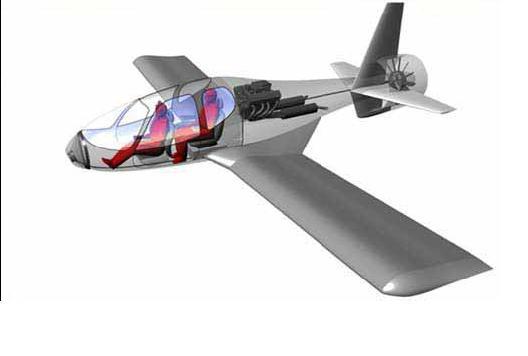This article is more than 1 year old
NASA comp fails to produce flying cars
Where the hell is my flying car?
NASA used to have it's own PAV project office at the Langley Research Centre in Virginia. The NASA PAV team was working on a demonstrator aircraft called "Tailfan", powered by a silenced V-8 car engine driving a specially-developed ducted fan unit rather than a normal prop, in order to cut down the noise. The plan was to have a TailFan plane flying by 2009, but NASA says (large pdf, page 64) it "redirected funding within its Vehicle Systems Program and the PAV activities at Langley were therefore terminated in 2005".

The NASA "TailFan" concept, cancelled in 2005.
That more or less killed the PAV off, but as a sop to flying car lovers NASA did offer some minimal prize funding to encourage private aviation enthusiasts to keep the idea going at their own expense, under the "Centennial Challenges" programme. The Cafe Foundation, a non-profit group of volunteer plane testers and PAV lovers, agreed to run the competition.
As one might expect, there were problems. Just $250,000 in prize money isn't a big incentive for people to design aircraft, or even to modify them much, given the very expensive regulatory and certification requirements - and the hard minimum targets set by NASA for anyone to win any of its prize cash. Despite significant relaxations in the rules, three teams dropped out in July leaving just four in the running.
The four teams weren't, naturally enough, able to offer anything even as advanced as the TailFan. Two modified Pipistrel Virus motorgliders, a Vans RV-4 and a familiar old Cessna 172 were entered. The Virus, flown by Australian Pipistrel pilot Michael Coates, scooped most of the cash, winning on shortest takeoff and best fuel efficiency to take the grand overall prize as well.
According to CNET's Stefanie Olsen, Coates characterised the Virus as the "Prius of airplanes". The $70,000 Virus isn't a hybrid, in fact, but it does get about 50 miles to the gallon going at up to 140mph. It's still no PAV, though: no folding wings, not very quiet, not even slightly road legal, and definitely no "synthetic vision" super-autopilot.
The RV-4, specially tricked out for quietness, won that event, and the trusty old Cessna - in production for 50 years - won the ease-of-handling prize.
"The results make sense," said NASA's Mark Moore, who was chief of the NASA PAV programme until it was shut down.
"The Cessna 172 is the most successful (and highest production volume small aircraft) precisely for the reason that the handling qualities are so good."
Moore praised the Virus for its light weight. "Only 682 pounds empty weight complete: it literally carries more useful load, that is passengers, fuel, and baggage, than the aircraft weighs."
It's hard to say that the cause of personal flying cars has been much advanced here, however. NASA had to relax its targets noticeably to even get teams to compete, and $250k for flying cars isn't drawing attention and effort the way $10m for private rocketplanes did in the case of the Ansari X-Prize.
"Next year the prizes are larger and will be harder to win," Moore told CNET. But there's only $2m in the kitty for five annual prizes. Unless some very rich flying car enthusiasts get involved, this concept is going to be a long time going anywhere at all.
The fact is, the Centennial Challenge tech-prize programme is appearing more and more as the graveyard where NASA sends ideas to die, rather than a place for schemes it actually believes in.
As for private backers, why would internet billionaires spend their fortunes developing flying cars - the way several of them are doing on spaceships to carry them and their superwealthy pals on suborbital jaunts? Billionaires don't have spaceships, but they already have helicopters and private jets. They probably aren't interested in making flying cars for ordinary people. ®
Disclaimer: Lewis Page holds a private pilot's licence, somewhat out of date and with no instrument rating. He wants a flying car more than almost anything. And a spaceship. He just doesn't believe anybody's going to let him have either.
